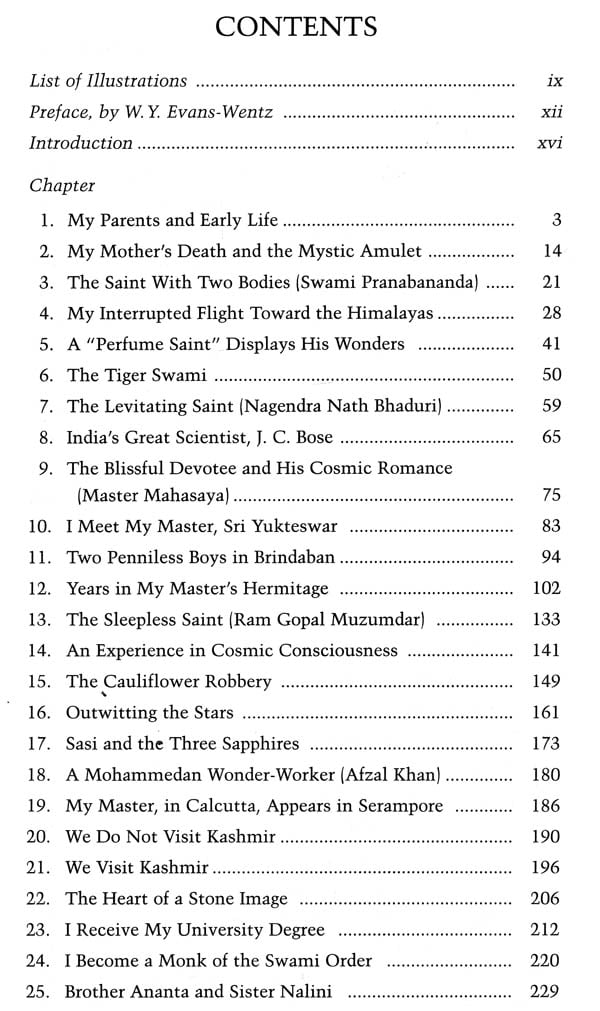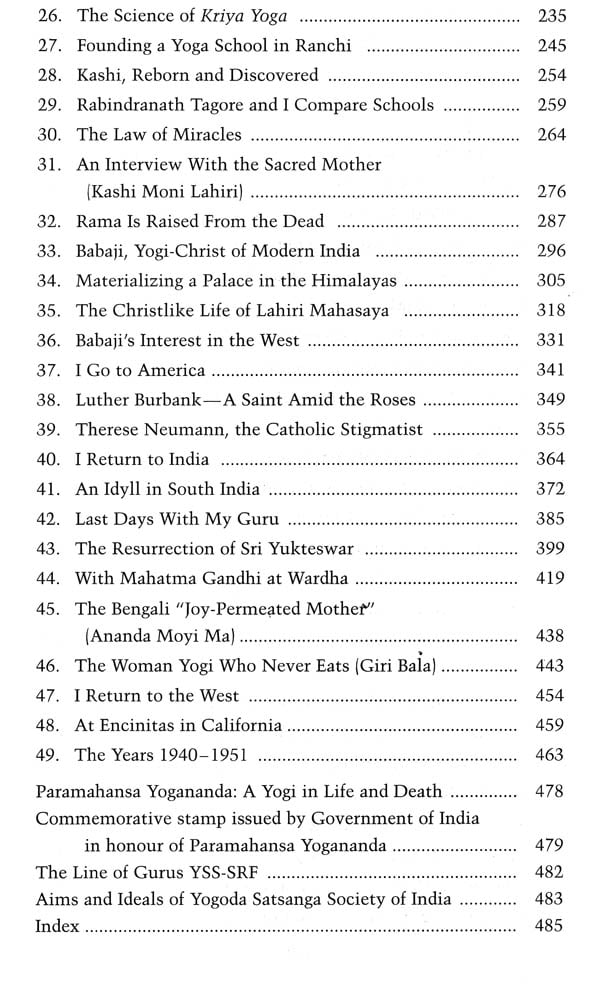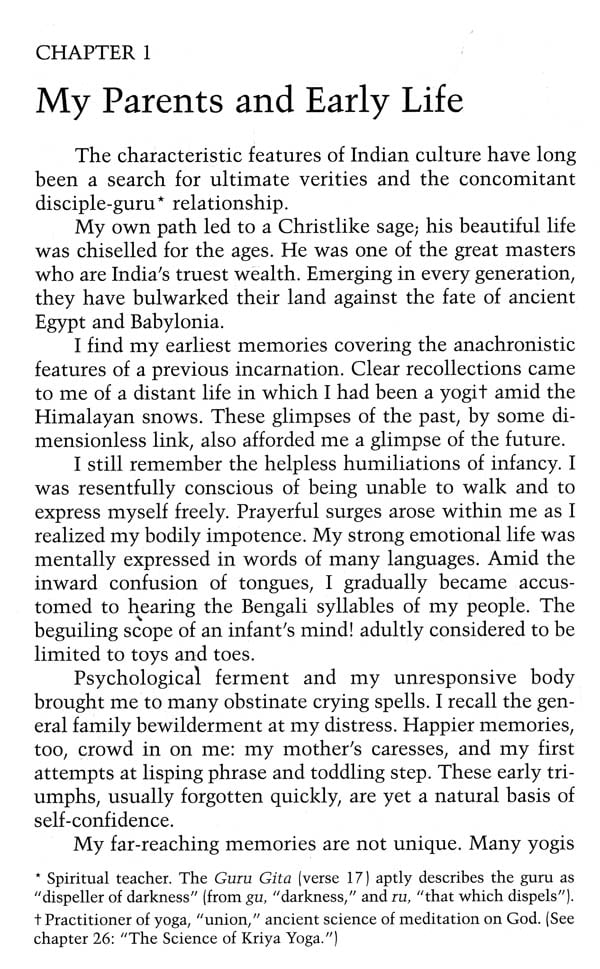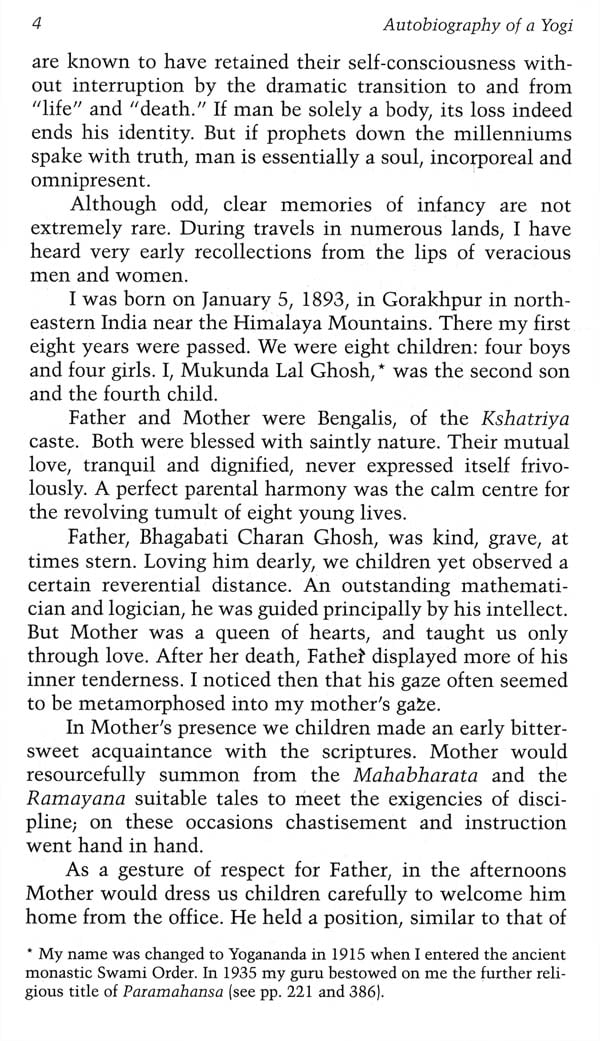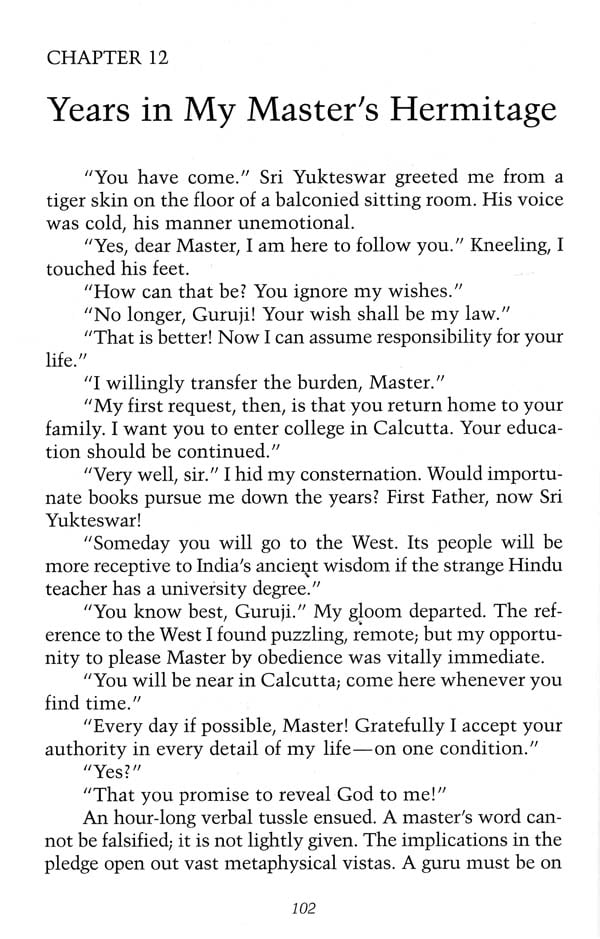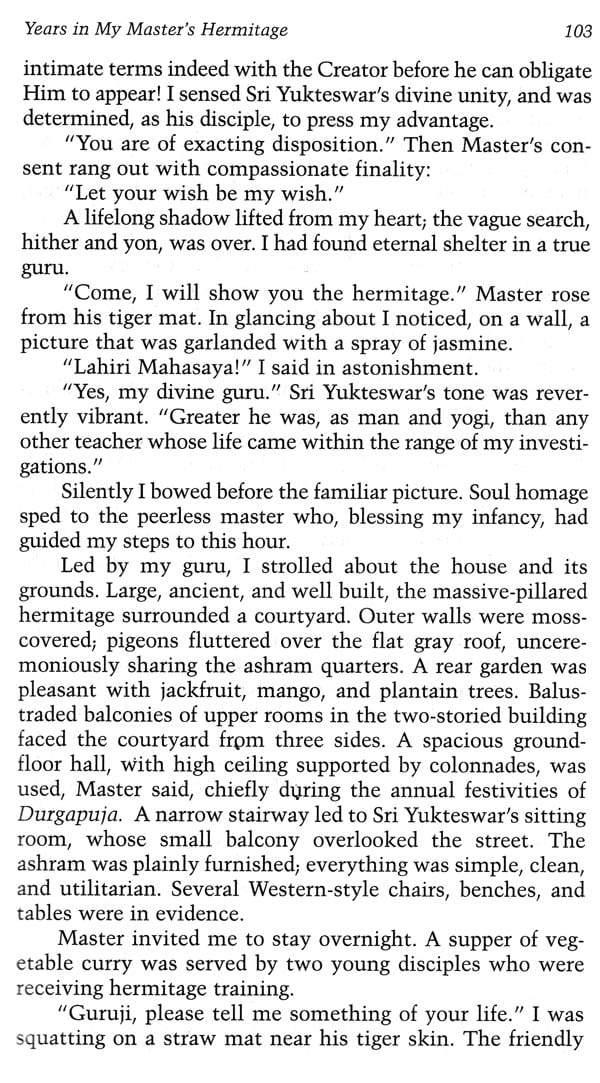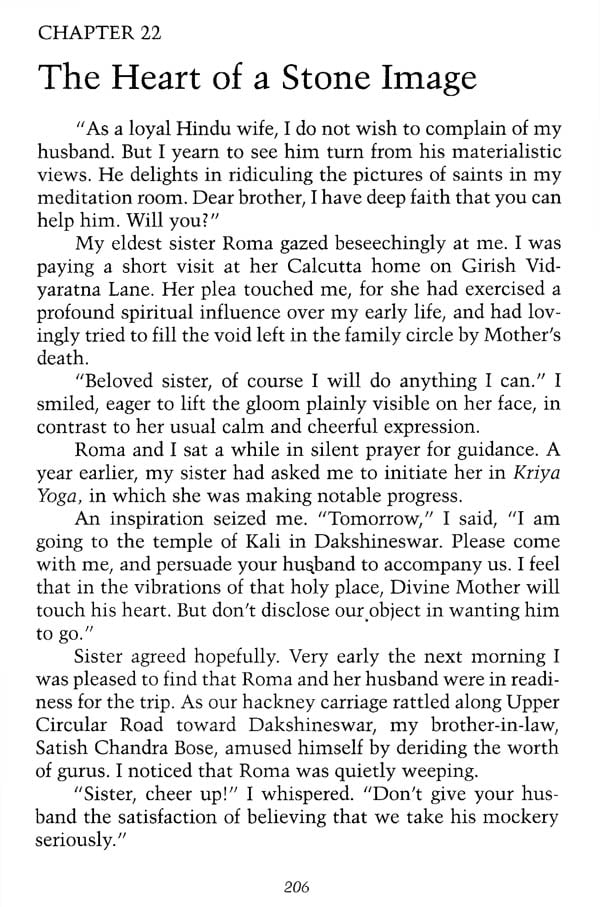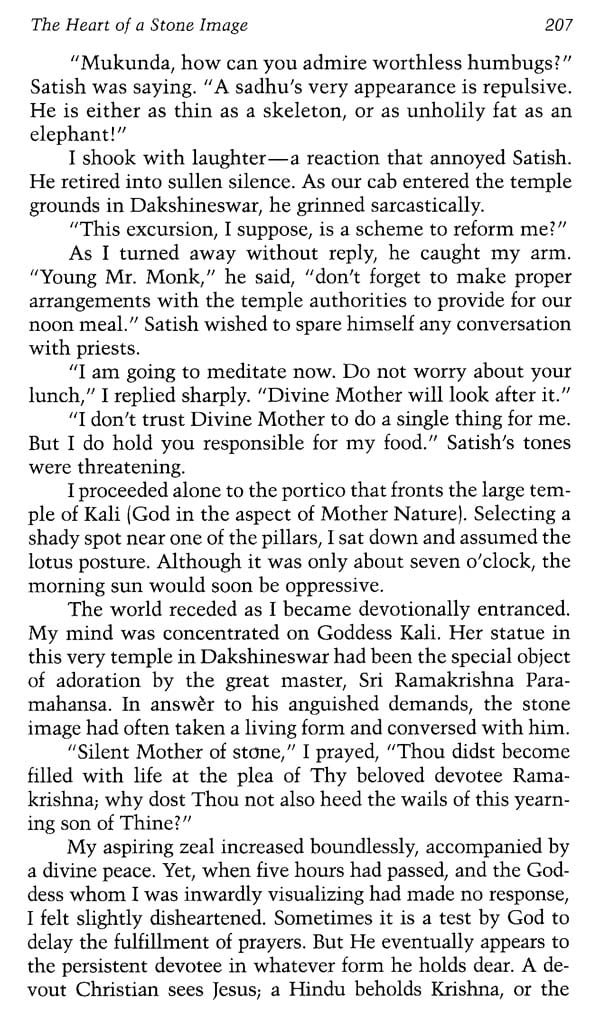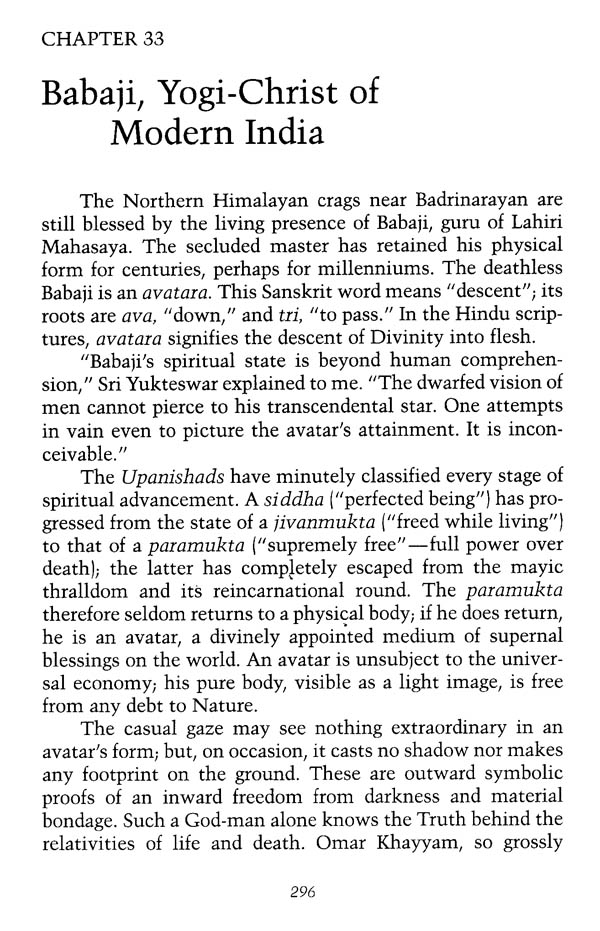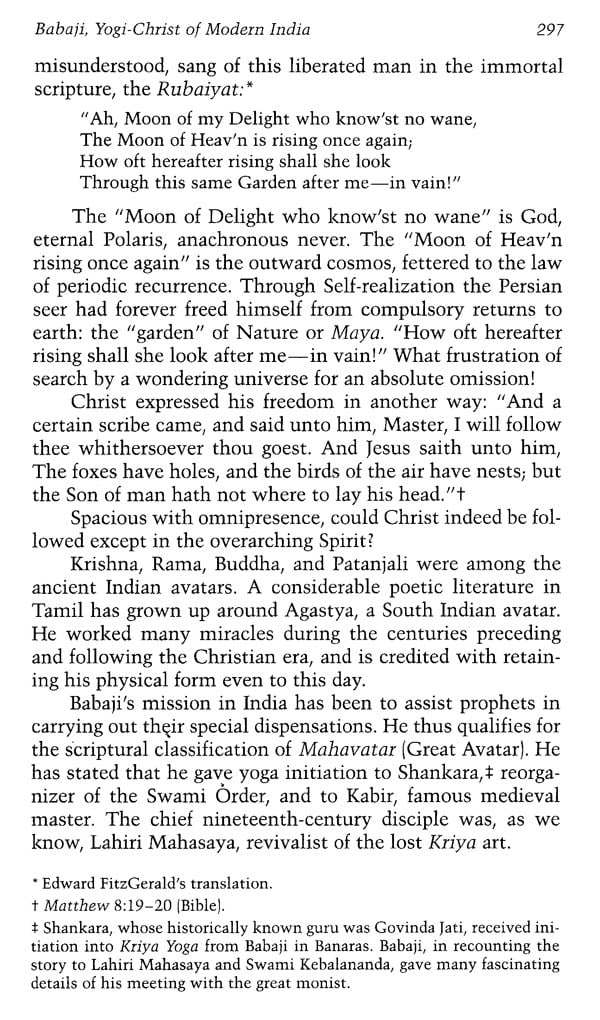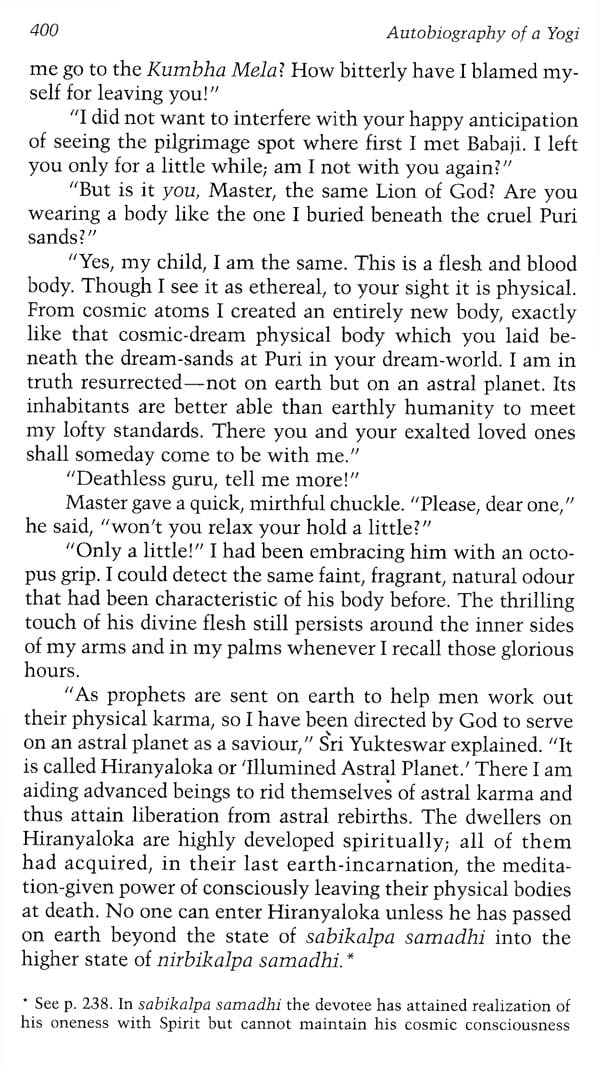
Autobiography Of A Yogi
Book Specification
| Item Code: | NAW826 |
| Author: | Paramahansa Yogananda |
| Publisher: | Yogoda Satsanga Society of India |
| Language: | English |
| Edition: | 2017 |
| ISBN: | 9788190256209 |
| Pages: | 535 (70 B/W Illustrations) |
| Cover: | HARDCOVER |
| Other Details | 8.50 X 5.50 inch |
| Weight | 650 gm |
Book Description
Born in Gorakhpur, Uttar Pradesh, on January 5, 1893, Sri Sri Paramahansa Yogananda devoted his life to helping people of all races and creeds to realise and express more fully in their lives the beauty, nobility, and true divinity of the human spirit.
After graduating from the Calcutta University in 1915, Sri Yogananda was initiated into sannyas by his guru Sri Sri Swami Sri Yukteswar Giri. Sri Yukteswar had foretold that his life's mission was to spread throughout the world, India's ancient meditation technique of Kriya Yoga. He accepted an invitation, in 1920, to serve as India's delegate to an International Congress of Religious Liberals in Boston, USA.
Paramahansa Yogananda founded Yogod, Satsanga Society of India/Self-Realization Fellowship as the channel for the dissemination of his teachings. Through his writings and extensive lecture tours in India, America, and Europe, as well as through the creation of numerous ashrams and meditation centres, he introduced thousands of truth-seekers to the ancient science and philosophy of Yoga and its universally applicable methods of meditation. Paramahansaji entered mahasamadhi on March 7, 1952 in Los Angeles.
Today the spiritual and humanitarian work begun by Paramahansa Yogananda continues under the guidance of Sri Sri Mrinalini Mata, personally chosen and trained by Paramahansa Yogananda to help guide the work after his passing. As Sanghamata and President of Yogoda Satsanga Society of India/Self-Realization Fellowship, Sri Mrinalini Mataji faithfully carries out Paramahansa Yoganandaji's ideals and wishes for the dissemination of his teachings worldwide.
The value of Yogananda's Autobiography is greatly enhanced by the fact that it is one of the few books in English about the wise men of India which have been written, not by a journalist or foreigner, but by one of their own race and training-in short, a book about yogis by a yogi. As an eyewitness recountal of the extraordinary lives and powers of modern Hindu saints, the book has importance both timely and timeless. To its illustrious author, whom I have had the pleasure of knowing in both India and America, may every reader render due appreciation and gratitude. His unusual life document is certainly one of the most revealing of the depths of the Hindu mind and heart, and of the spiritual wealth of India, ever to be published in the West.
It has been my privilege to meet one of the sages whose life history is herein narrated-Sri Yukteswar Giri. A likeness of the venerable saint appeared as part of the frontispiece of my Tibetan Yoga and Secret Doctrines. * It was at Puri, in Odisha, on the Bay of Bengal, that I encountered Sri Yukteswar. He was then the head of a quiet ashrama near the seashore there, and was chiefly occupied in the spiritual training of a group of youthful disciples. He expressed keen interest in the welfare of the people of the United States and of all the Americas, and of England, too, and questioned me concerning the distant activities, particularly those in California, of his chief disciple, Paramahansa Yogananda, whom he dearly loved, and whom he had sent, in 1920, as his emissary to the West.
Sri Yukteswar was of gentle mien and voice, of pleasing presence, and worthy of the veneration that his followers spontaneously accorded to him. Every person who knew him, whether of his own community or not, held him in the highest esteem. I vividly recall his tall, straight, ascetic figure, robed in the saffron-coloured garb of one who has renounced worldly quests, as he stood at the entrance of the hermitage to give me welcome. His hair was long and some-what curly, and his face bearded. His body was muscularly firm, but slender and well-formed, and his step energetic. He had chosen as his place of earthly abode the holy city of Puri, whither multitudes of pious Hindus, representative of every province of India, come daily on pilgrimage to the famed Temple of Jagannath, "Lord of the World." It was at Puri that Sri Yukteswar closed his mortal eyes, in 1936, to the scenes of this transitory state of being and passed on, knowing that his incarnation had been carried to a triumphant completion.
I am glad, indeed, to be able to record this testimony to the high character and holiness of Sri Yukteswar. Content to remain afar from the multitude, he gave himself unre-servedly and in tranquillity to that ideal life which Paramahansa Yogananda, his disciple, has now described for the ages.
To those who were personally acquainted with Paramahansa Yogananda, his own life and being were convincing testimony to the power and authenticity of the ancient wisdom he presented to the world. Countless readers of his autobiography have attested to the presence in its pages of that same light of spiritual authority that radiated from his person. Hailed as a masterpiece when it first appeared in print more than sixty years ago, the book set forth not only the story of a life of unmistakable greatness but a fascinating introduction to the spiritual thought of the East-especially its unique science of direct personal communion with God-opening up to the Western public a realm of knowledge hitherto accessible only to a few. Today Autobiography of a Yogi is recognized around the world as a classic of spiritual literature. In this introduction, we would like to share some of the book's extraordinary history.
The writing of the work had been prophesied long ago. One of the seminal figures in the renaissance of yoga in modern times, the revered nineteenth-century master Lahiri Mahasaya, had foretold: "About fifty years after my passing, an account of my life will be written because of a deep interest in yoga that will arise in the West. The message of yoga will encircle the globe. It will aid in establishing the brotherhood of man: a unity based on humanity's direct perception of the One Father."
Many years later, Lahiri Mahasaya's exalted disciple Swami Sri Yukteswar related this prophecy to Sri Yogananda. "You must do your part in spreading that message," he declared, "and in writing that sacred life."
It was in 1945, exactly fifty years after Lahiri Mahasaya's passing, that Paramahansa Yogananda completed his Autobiography of a Yogi, which amply fulfilled both of his guru's injunctions: providing, the first detailed presentation in English of Lahiri Mahasaya's remarkable life, and introducing to a world audience India's age-old science of the soul.
The creation of Autobiography of a Yogi was a project that Paramahansa Yogananda worked on over a period of many years. Sri Daya Mata, one of his earliest and closest disciples, * recalls:
"When I came to Mount Washington in 1931, Paramahansaji had already begun to work on the Autobiography. Once when I was in his study attending to some secretarial duties, I was privileged to see one of the first chapters he wrote-it was on 'The Tiger Swami.' He asked me to save it, and explained that it would be going into a book he was writing. Most of the book was composed later, between 1937 and 1945."
From June 1935 through October 1936, Sri Yogananda had made a return trip to India (via Europe and Palestine) for a last visit with his guru, Swami Sri Yukteswar. While there, he had compiled much factual data for the Autobiography, as well as stories about some of the saints and sages whom he had known and whose lives he was to describe so memorably in the book. "I had never forgotten Sri Yukteswar's request that I write the life of Lahiri Mahasaya," he later wrote. "During my stay in India I was taking every opportunity to contact direct disciples and relatives of the Yogavatar. Recording their conversations in voluminous notes, I verified facts and dates, and collected photographs, old letters, and documents." Upon his return to the United States at the end of 1936, he began to spend much of his time at the hermitage that had been built for him in his absence, in Encinitas on the southern California coast. It proved to be an ideal place to concentrate on completing the book he had begun years before. "Still vivid in my memory are the days spent in that peaceful seaside hermitage," recounts Sri Daya Mata. "He had so many other responsibilities and commitments that he was not able to work on the Autobiography every day; but in general he devoted the evenings to it, and whatever free time he could spare. Beginning around 1939 or '40, he was able to concentrate full time on the book. And full time it was-from early morning until early morning! A small group of us disciples-Tara Mata; my sister, Ananda Mata; Sraddha Mata; and myself -were present to assist him. After each part was typed, he would give it to Tara Mata, who served as his editor. "What treasured memories! As he wrote, he relived inwardly the sacred experiences he was recording. His divine intent was to share the joy and revelations encoun-tered in the company of saints and great masters and in one's own personal realization of the Divine. Often he would pause for a time, his gaze uplifted and his body motionless, rapt in the samadhi state of deep communion with God. The whole room would be filled with a tremen-dously powerful aura of divine love. For us disciples, mere-ly to be present at such times was to be lifted into a higher state of consciousness.
**Contents and Sample Pages**
